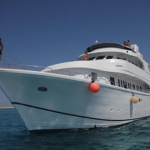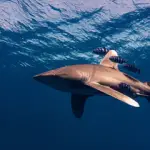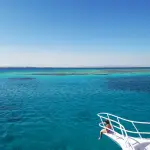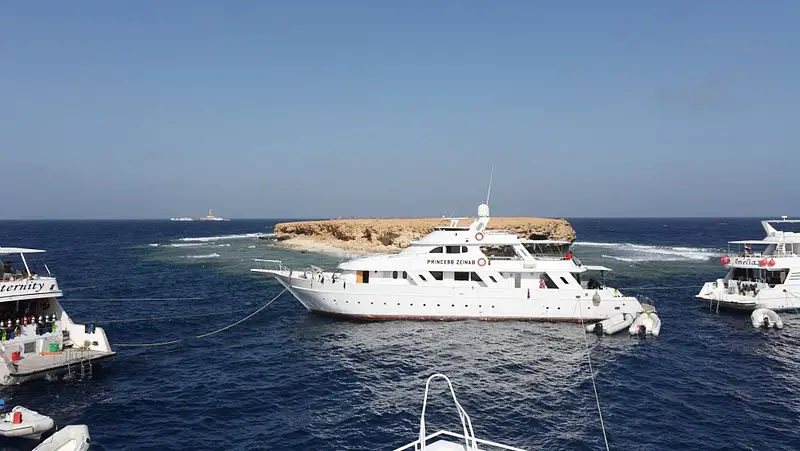
If you love the idea of scuba diving with sharks, diving The Brothers Islands in the Red Sea is a must do dive. But for you to get the most from the Brothers Islands scuba diving, you owe it to yourself to have the right level of diving experience and the correct scuba diving certification (see below).
But the Brothers Islands cannot be accessed from any land-based sites in Egypt, so how do you get to the best scuba diving in the Red Sea and Egypt?
The Brothers Islands scuba diving has to be one of the best dive sites in the Red Sea and should be at the top of your list of dives to experience sharks and wrecks all in one. The Brothers Islands Red Sea can only be reached by diving liveaboard, as it’s too far offshore for any day boats to reach.
The best way to dive the Red Sea, and especially the best and more remote locations in the Red Sea, is by a scuba diving liveaboard. You can check the latest and best deals on Red Sea liveaboards using the following window:
If you would like to know which liveaboards visit The Brothers Islands, you can find this out from this very handy Red Sea liveaboard dive boat table.
You can also search the best Red Sea Liveaboards in the table below:
Table of liveaboard diving in the Red Sea
This list of Red Sea liveaboards is in descending customer rating order, followed by Scuba Diving Luxury Rating (SDE Lux Rating, see below), so the liveaboards with the highest customer rating and the best SDE lux rating will be at the top of the list. If you want to change the list order, use the “Sort by” dropdown below.
| Discover Liveaboard | Customer Rating | SDE Lux Rating % | Flexible Booking | Dive Courses | Dietary Requirements | Nitrox | Gear Rental | |
|---|---|---|---|---|---|---|---|---|
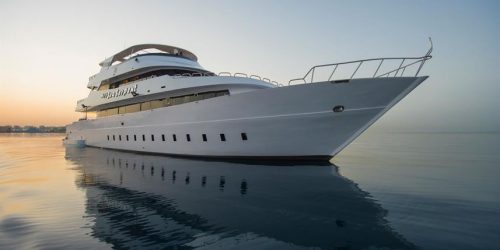 |
Review: MY Sea Serpent; Book: MY Sea Serpent | 8.9 | 65% | YES | YES | YES | YES | YES |
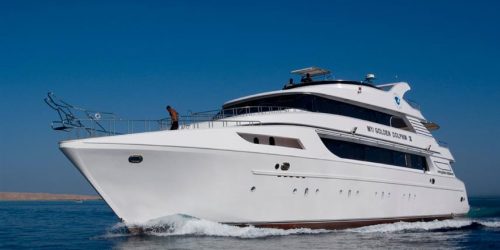 |
Review: MY Golden Dolphin III; Book: MY Golden Dolphin III | 8.9 | 62% | YES | YES | YES | YES | YES |
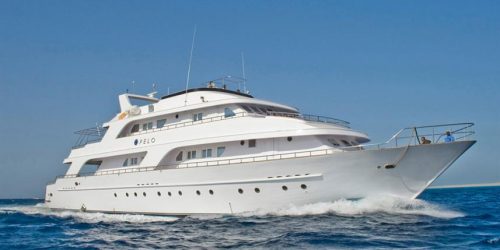 |
Review: MY Seawolf Felo; Book: MY Seawolf Felo | 8.9 | 56% | YES | YES | YES | YES | YES |
 |
Review: MY Firebird; Book: MY Firebird | 8.8 | 71% | YES | YES | YES | YES | YES |
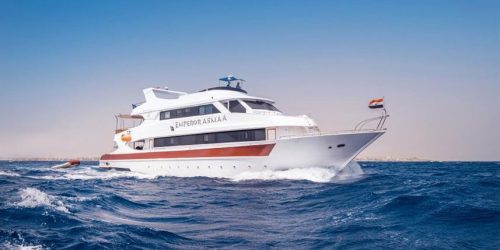 |
Review: MY Emperor Asmaa; Book: MY Emperor Asmaa | 8.8 | 71% | YES | YES | YES | YES | YES |
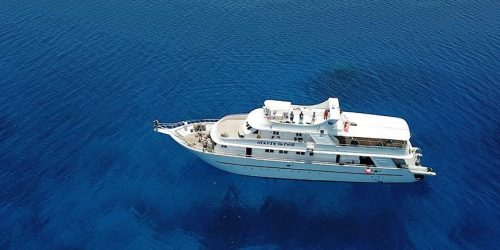 |
Review: MV Heaven Saphir; Book: MV Heaven Saphir | 8.7 | 88% | YES | YES | YES | YES | YES |
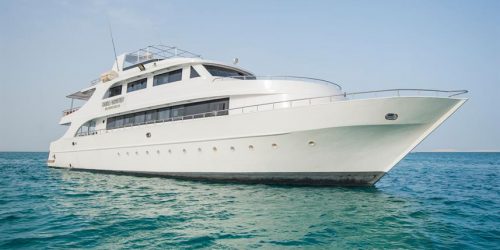 |
Review: MY Discovery II (Samira); Book: MY Discovery II (Samira) | 8.7 | 83% | NO | YES | YES | YES | YES |
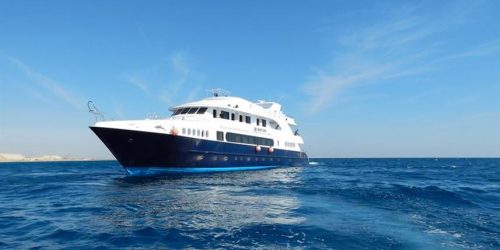 |
Review: MY JP Marine; Book: MY JP Marine | 8.7 | 81% | YES | YES | YES | YES | YES |
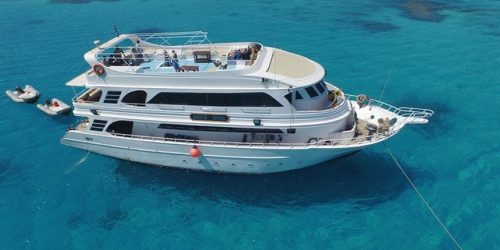 |
Review: MV South Moon; Book: MV South Moon | 8.7 | 79% | YES | YES | YES | YES | YES |
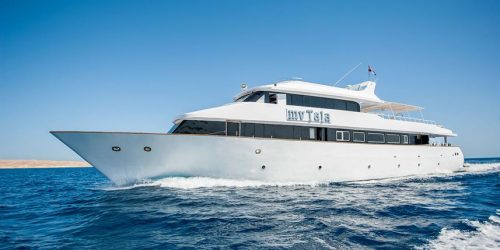 |
Review: MV Tala; Book: MV Tala | 8.7 | 71% | YES | YES | YES | YES | YES |
The Scuba Diving Earth Luxury Rating (SDE Lux Rating) is explained on each liveaboard review when you click the “Discover Liveaboard” link, and is my own Liveaboard Luxury Rating I’ve assigned to all liveaboards. Choosing between liveaboards is helped by customer scores, and if you get stuck choosing between two or three liveaboards, where each one has a high customer score out of 10, you can use the SDE Luxury Rating to help narrow down your choice.
Think about it like using Booking.com when searching for the best hotel. Booking.com also use a customer score where each customer rates hotels out of 10. This is similar to the liveaboard customer rating, which is also rated out of 10. But let’s say you only like to stay in hotels rated 8 and above on Booking.com, but you also want the hotel to have WIFI or parking, or to have a swimming pool etc. The features each hotel has is usually secondary to the score out of 10.
Another option is for you to take a look to see “what divers are saying about the Brothers diving” at the same time as reviewing the “most popular Brothers liveaboards“.
There is a mixed bag of reviews, but here’s an example of a few of the better The Brothers reviews:
- “Except for the current a very nice place for diving“.
- “Wrecks or whalesharks… don’t know which way to look“.
- “Little Brother was the highlight of the trip. Loads of fish and sharks.”.
- “Very nice diving with hammerhead sharks!“.
- “Excellent- we saw sharks!“.
- “Fantastic… thresher shark for my birthday how can I complain!“
There’s a whole page of these reviews, which you can read here: The Brothers Reviews.
I have also gone through 135 scuba diver reviews of The Brothers diving and compared which months are better for sharks, manta rays and the best of the reviews that scored the diving more than 9 out of 10. It turns out that the best months for scuba diving with sharks at The Brothers are August and November, followed closely by May and December.
August is also the best month for whale sharks, manta rays, thresher sharks and hammerheads from the information in the table. But the months that received the best customer reviews are May and August.
My findings are displayed in the table below:
The Brothers diving reviews and shark sightings table
| Month of The Brothers dive | Scuba Diver Ratings Over 9 out of 10 | Best Month For Shark Sightings | Best Month For Whale Shark Sightings | Best Month For Hammerhead Sightings | Best Month For Oceanic Whitetip (Longimanus) Shark Sightings | Best Month For Thresher Shark Sightings | Best Month For Manta Ray Sightings |
|---|---|---|---|---|---|---|---|
| 01. January | 0 | 0 | 0 | 0 | 0 | 0 | 0 |
| 02. February | 2 | 0 | 0 | 0 | 0 | 0 | 0 |
| 03. March | 2 | 1 | 0 | 0 | 0 | 1 | 0 |
| 04. April | 5 | 2 | 0 | 0 | 0 | 0 | 0 |
| 05. May | 12 | 8 | 0 | 3 | 1 | 1 | 1 |
| 06. June | 9 | 4 | 1 | 1 | 1 | 0 | 0 |
| 07. July | 10 | 6 | 1 | 4 | 0 | 1 | 0 |
| 08. August | 13 | 15 | 3 | 5 | 0 | 4 | 2 |
| 09. September | 5 | 5 | 0 | 2 | 0 | 0 | 0 |
| 10. October | 5 | 6 | 0 | 3 | 1 | 1 | 0 |
| 11. November | 10 | 12 | 0 | 4 | 1 | 2 | 0 |
| 12. December | 10 | 8 | 1 | 0 | 1 | 0 | 0 |
2. The reviews are across both Little Brother and Big Brother Islands.
3. It should be noted that not all people who rated the diving mentioned sharks in their review, even though they may have seen sharks when they dived.
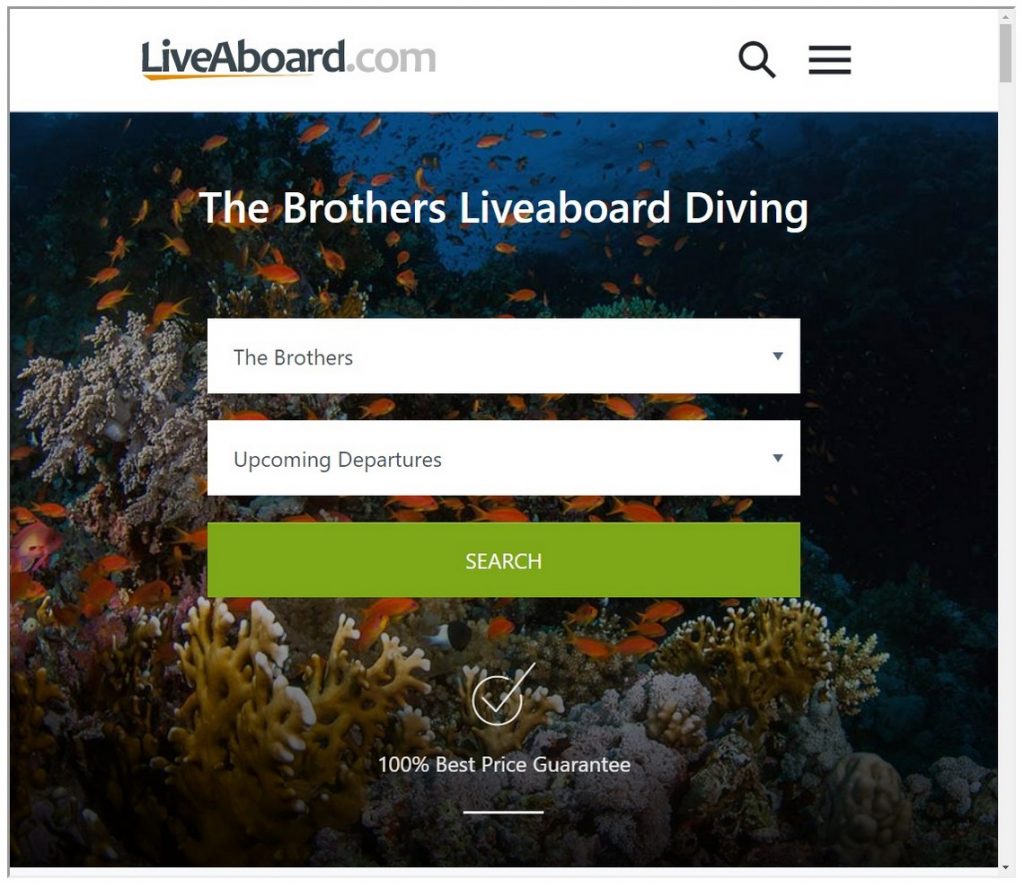
Brothers Islands scuba diving (El Akhawein or Al Ikhwan)
The Brothers Islands, which is known locally as El Akhawein, is one of the best dive sites in the Red Sea for scuba diving with sharks.
The Brothers Red Sea is known for its sharks, and if you’re lucky you’ll get to meet an Oceanic Whitetip Shark.
The Brothers Islands are one of only a handful of places on Earth where you get the chance to scuba dive with Oceanic Whitetip sharks (Carcharhinus Longimanus). The other places are also in the Red Sea, which are Elphinstone Reef and Daedalus Reef.
The other sharks seen at the Brothers Islands include, hammerheads, grey reef sharks, silvertip reef sharks and you may be lucky to see a whale shark there too.
Whale Shark at Big Brother Island, Egyptian Red Sea
Be aware that if you are lucky enough to experience Oceanic Whitetip sharks at the Brothers Islands, they can be extremely inquisitive around scuba divers, especially as you near the surface and you’re mid-water.
Caution is recommended when Oceanic Whitetips are around and these sharks are close-by, always remain vertical in the water, as you are more of a target when you’re horizontal. Keep your eyes on the sharks at all times. You are also better to remain in a close group too, as sharks are opportunists and will seek out individual targets.
I don’t want to worry you, but the following video is worth watching before you go scuba diving the Brothers, Red Sea: The Brothers Island shark attack by Oceanic Whitetip. Discover in this article how the shark attack could have been avoided if the diver had followed the four rules of safe diving with sharks.
I’ll let this video do the talking, which is Big Brother and Small Brother (El Akhawein):
Dive footage from the Red Sea in December 2015. Dive site, Big Brother and Small Brother (El Akhawein).
Who can scuba dive the Brothers Islands?
To scuba dive the Brothers Islands you need to be an Advanced Open Water Diver with PADI or an equivalent dive certification, and have at least 50 logged dives. You need this level of scuba diving experience due to the dive depths and on occasion the very strong and unpredictable currents. So you need drift diving experience to scuba dive the Brothers Islands.
If you are wondering why you need this level of experience, I recommend you read this article, which is about how to deal with a down current and not panic. But if you want to know what happened to me on Elphinstone Reef in a strong down current, please jump straight to this section of the article: What would you do in this down current situation?
What type of diving is the Brothers Islands?
The diving on the Brothers Islands is not for the faint hearted, as the currents can be strong and the best dives are around 30 metres (100 feet) deep on the southern tip of Big Brother for sharks. The current usually runs north to south and is often strong, and can be two knots (2.3 mph)* or stronger.
The diving from a Red Sea liveaboard often begins from a Zodiac, as the liveaboard boat will be anchored at an anchoring point on one of the two islands. The dive will begin with a backwards roll entry.
Always get on the early morning dive, as this is the best time to see sharks and is likely to be less busy too.
Keep an eye on your dive computer to avoid going into decompression dive time, unless that is your intention as a technical diver.
But also keep an another eye on your air consumption, as you want to keep enough air to finish the dive.
Make sure to keep looking out into the blue as you drift along the face of the drop-off, as you may be lucky to see sharks.
Don’t forget to do your safety stop at 5-6 metres (15-20 feet) before ascending to the surface.
Diving conditions and diver requirements for the Brothers Islands
- Strong winds give rise to big waves which makes entering and leaving the water challenging.
- Expect strong currents that flow along the reef walls.
- The currents can change drastically and in intensity during a dive.
- Divers have to be cautious not to be swept out into the open sea by the currents.
- Currents often circulate around the southern tip of Little Brother, which can lead to unexpected counter currents.
- The challenging diving conditions and depth of the dives make them not suitable for beginner divers.
- By law the requirement is a minimum of 50 logged dives.
- PADI Advanced Open Water Diver or equivalent.
- Drift diving training and experience.
- Good buoyancy control skills, as you’ll be wall diving over an abyss.
- Diver certification that allows you to dive to 30 metres (99 feet) or more.
- Experience of diving from a Zodiac boat will help, even if you are on a liveaboard dive boat, as the Zodiac will drop divers into the water.
- Due to strong currents and the risk of being carried out into the open sea night diving is prohibited.
- Always recommended to stay close to the wall or reef and to watch your depth.
- Being able to remain calm when scuba diving with sharks nearby, especially with the highly inquisitive Oceanic Whitetips*.
* Oceanic Whitetip Shark – Close Encounter with Divers – The Brothers Islands Red Sea Egypt:
An Aggressive Longimanus Shark tries to attack two Divers in RED SEA
What will you see diving the Brothers Islands?
- Hammerhead sharks.
- Oceanic Whitetip sharks.
- Turtles.
- Shoals of barracuda.
- Snapper.
- Tuna.
- Numerous reef fish.
- Moray eels.
- Colourful reefs.
- Thresher sharks.
- Grey reef sharks.
- Silvertip sharks
- Blacktip reef sharks.
- Manta rays.
- Whale sharks (if you are lucky – see above video).
How to get to the Brothers Islands
Diving at The Brothers is only possible by liveaboard boat and is reachable from Hurghada, Port Ghalib, Marsa Ghalib and Sharm El-Sheikh or there are a few dive liveaboards based in Marsa Alam too.
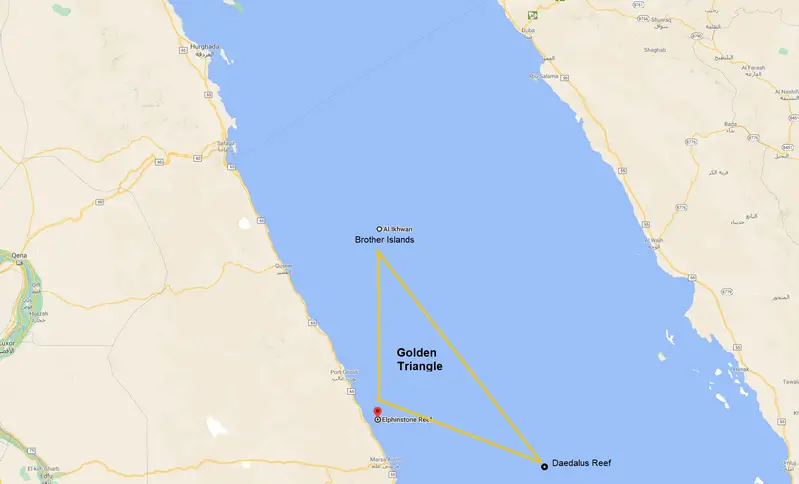
Where are the Brothers Islands in the Red Sea – The Brothers Egypt Map
The Brothers Islands are located in the middle of the Red Sea, roughly 180 kilometres (113 miles) south east of Hurghada and 80 km (50 miles) almost directly east of El Quseer on the coast of Egypt.
The Brothers Islands, Elphinstone Reef and Daedalus Reef are the golden triangle of dive sites in the Red Sea. Elphinstone Reef is about 120km (75 miles) south of the Brothers. Whereas Daedalus Reef is nearly 200km (125 miles) south from the Brothers Islands.
The Brothers are two islands
The Brothers are made up of two islands, Big Brother and Little Brother, which are roughly 2km (1.25 miles) apart.

Big Brother Island
Big Brother is the larger of the two islands and is good for shark diving, colourful reef diving and wreck diving on three wrecks, the third wreck is a tech diver depths.
Big Brother Island includes the following dive site details:
- Big Brother has a lighthouse and is inhabited by Egyptian soldiers.
- Island is 480 metres (1,575 feet) long.
- Big Brother rises 10 metres (33 feet) above sea level.
- The island is surrounded by a colourful fringing reef.
- A wall dive where the seafloor drops to a depth of over 800 metres (2,625 feet).
- The walls are full of hard and soft corals and gorgonian sea fans.
- Strong currents bring plankton and nutrients, which creates an abundance of life and corals.
- To the north west is a 300 metre (984 feet) plateau at a maximum depth of 10 metres (33 feet).
- To the south east of the island is a small ridge at 30 metres (100 feet), which is good for spotting sharks.
- Likely to spot anthias, glassfish, sweepers, snapper, tuna, barracuda and surgeonfish.
- One of the biggest opportunities to spot sharks in the Red Sea is the southern east point of Big Brother Island.
- Sharks spotted on Big Brother include oceanic whitetip sharks, grey reef sharks, hammerhead sharks and the occasional tiger shark.
- Dawn dives in the autumn and winter months may reward you with a signing of thresher sharks, although August seems to be a good month to spot thresher sharks.
- Ship wreck the Numidia, known as the railway wreck as it had two locomotive wheels onboard when it sank, is on the northern tip at a depth of 8-90 metres (26-295 feet). The propeller of the Numidia is at 90 metres (295 feet), which is beyond recreational dive limits and at technical diving depths.
- Ship wreck the Aida is on the southwest wall at 7-65 metres (23-213 feet) deep. If you want to see the propeller, which is at 65 metres, you will need to be a technical diver to do so.
- Ship wreck the Karim is on the southern tip at 70 metres (230 feet) only accessible by technical divers (Please check this list of the best technical Red Sea liveaboards).
For help in choosing the best Red Sea liveaboard for you, please go to this article which includes a very handy table of all Red Sea Liveaboards. The table includes all the information you need to help you choose the right Red Sea dive liveaboard for you: The Best Red Sea Liveaboard Dive Boats.
Video of the Numidia Wreck at Big Brother island Red Sea:
During our TEC week on the M/Y Blue Fin with the crew from Blue O Two, we got to dive the Numidia, and penetrate the wreck as we worked our way up from 45m. The Numidia lies against the reef out on the north side of the western plateau of Big Brother Island.
Or how about this for a fun technical dive going from the Aida wreck to the Numida wreck using underwater scooters.
If you are a technical diver or if you want rebreather support on a Red Sea liveaboard, plus if you fancy diving with an underwater scooter like in the above video, please take a look at this article about Liveaboards With Underwater Scooters. Take a look at the Red Tala liveaboard, which is reviewed in this article.
This is one of the most spectacular dives on the Red Sea. This dive start our with divers passing below the Aida wreck at around 75 meters. Then moving around the Reef to Numidia, up through its hull form 80 meters to start the deco inside the wreck at around 21 meters. Then they scooter back to the boat passing over the Aida wreck again. What is important to notice in this video is the skills of the video operator, Nick Poole. He is conducting the same dive and taking these spectacular shots with seamless panning in and out. At the same time handling all his gear and scooter and all.
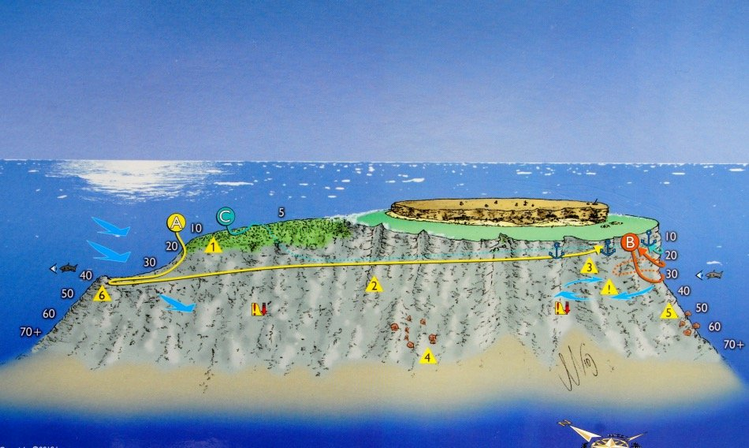
Little Brother
Little Brother Island is the smaller of the two Brothers Islands, which is great for scuba diving with sharks and for colourful reef diving.
Little Brother Island includes the following dive site details:
- Little brother is an uninhabited island.
- Island is 170 metres (558 feet) long.
- From an aerial view is in the shape of a rain drop.
- Little Brother rises about 4 metres (13 feet) above sea level.
- The island is surrounded by a colourful fringing reef.
- A wall dive where the seafloor is at a depth of over 700 metres (2,297 feet).
- The walls are full of hard and soft corals, including black corals and mammoth gorgonian fans.
- Strong currents bring plankton and nutrients, which creates an abundance of life and corals.
- Likely to spot Napoleon fish, snapper, damselfish, dogtooth tuna and surgeonfish.
- To the north of the island you may spot grey reef sharks, oceanic whitetip sharks and the occasional hammerheads or thresher sharks.
- There’s a rocky protrusion or plateau at the north west of Little Brother at a depth of 40 metres (131 feet), which is one of the best places to dive with sharks like grey reef sharks, silvertips and hammerheads.
For help in choosing the best Red Sea liveaboard for you, please go to this article which includes a very handy table of all Red Sea Liveaboards. The table includes all the information you need to help you choose the right Red Sea dive liveaboard for you: The Best Red Sea Liveaboard Dive Boats.
When is the best time to dive the Brothers Islands?
You can dive the Brothers Islands all year round, but the following is worth noting:
- In the winter months from November to December sea conditions can be challenging to the extent trips are cancelled.
- Water temperature in the winter months is 23°C (73°F).
- Water temperature in the summer months is 30°C (86° F).
- The best time to dive the Brothers for calm seas is June to August.
- Sharks are present all year-round.
- Shark sightings increase from May, which is when there is more chance to see hammerhead sharks.
- In the winter months you are more likely to see thresher sharks as these prefer colder waters.
Can you get to the Brothers Islands by day boat?
You cannot get to the Brothers Islands by day boat, as it’s 180km (113 miles) from Hurghada, which is too far to reach on a day trip.
The Brothers Island snorkeling
It isn’t advisable to snorkel the Brothers Islands, due to the strong currents that could sweep you out to the open ocean. Plus the sea conditions can be rough when it’s windy, which would make it unsafe to go snorkeling.
Seeing that you may like the idea of scuba diving with sharks, you may like to read this article about great white sharks in the Caribbean and the Gulf of Mexico.
You may be surprised by what you read, I certainly was!
This article is also interesting about a great white shark pinged near to the Maldives.
But then if you want to be really surprised, take a read of this article about a great white shark spotted by a snorkeler off the southern Great Barrier Reef. The article includes a video of the white shark concerned.
I hope you enjoyed this page about the Brothers Islands scuba diving
If you have more questions either about snorkelling or scuba diving (or specifically about the Brothers Islands scuba diving), please comment below with your questions.
Please share your experiences, plus dive sites, resorts and liveaboards you recommend. Share the time of year of your trip together with what you saw, the visibility, currents and dive operator, as this will help others who read this page.
There will also be many more pages and articles about scuba and scuba diving safety tips (and on snorkelling too) for you to read and learn about this fabulous sport.
Have fun and be safe!

